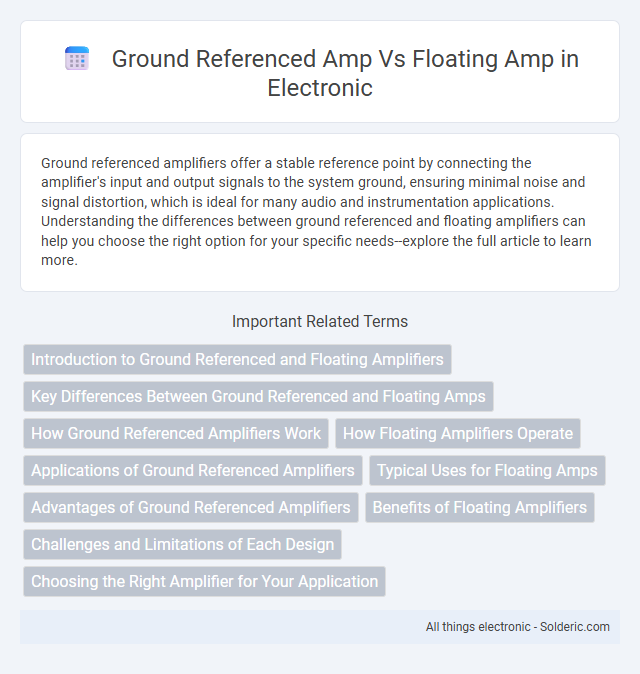Ground referenced amplifiers offer a stable reference point by connecting the amplifier's input and output signals to the system ground, ensuring minimal noise and signal distortion, which is ideal for many audio and instrumentation applications. Understanding the differences between ground referenced and floating amplifiers can help you choose the right option for your specific needs--explore the full article to learn more.
Comparison Table
| Feature | Ground Referenced Amplifier | Floating Amplifier |
|---|---|---|
| Reference Point | Connected to system ground | Isolated from ground, no direct reference |
| Signal Integrity | Good for low-noise, stable signals | Ideal for measuring signals with common-mode voltage |
| Common-Mode Rejection | Lower due to ground loops | Higher, better noise immunity |
| Applications | Audio amplifiers, low-voltage sensors | Isolated sensor interfaces, high-voltage measurements |
| Safety | Less safe in high-voltage scenarios | Inherently safer for floating voltage measurements |
| Complexity | Simpler design, easy integration | More complex, requires isolation components |
Introduction to Ground Referenced and Floating Amplifiers
Ground referenced amplifiers have their input or output connected directly to a common ground, ensuring stable voltage levels and minimizing noise in signal processing devices. Floating amplifiers, on the other hand, operate without a fixed connection to ground, allowing for measurement in environments with different ground potentials or in isolated circuits. Your choice between these amplifier types depends on the application's need for noise immunity or electrical isolation.
Key Differences Between Ground Referenced and Floating Amps
Ground referenced amps have their output connected directly to the system ground, providing a stable reference point that minimizes noise and simplifies circuit design. Floating amps, on the other hand, are isolated from the ground and can measure differential signals without being affected by common-mode voltages, making them ideal for applications with varying or high common-mode noise. Understanding these key differences helps you select the appropriate amplifier type for your specific signal conditioning and noise immunity requirements.
How Ground Referenced Amplifiers Work
Ground referenced amplifiers operate by connecting the negative terminal of the input signal directly to a common ground, which serves as a stable reference point for voltage levels. This design simplifies the circuit and reduces noise by maintaining a consistent voltage potential, enhancing signal integrity. Your choice of a ground referenced amplifier ensures predictable performance in applications where signals share a common ground.
How Floating Amplifiers Operate
Floating amplifiers operate without a direct connection to ground, allowing their input and output signals to reference different voltage levels independently. Their design incorporates isolation techniques such as differential inputs and isolated power supplies to prevent ground loops and noise interference. This functionality is crucial in applications requiring signal integrity across varying potential differences and electrically noisy environments.
Applications of Ground Referenced Amplifiers
Ground referenced amplifiers are commonly used in applications where a stable reference point is essential, such as audio equipment, instrumentation, and sensor signal conditioning. These amplifiers provide reliable performance in environments with minimal noise interference, making them ideal for precise measurements and signal processing in medical devices and communication systems. You benefit from their consistent reference to ground, which ensures accuracy and reduces signal distortion in your electronic circuits.
Typical Uses for Floating Amps
Floating amps are commonly employed in situations requiring isolation from the ground to prevent ground loops and reduce electrical noise, such as in audio equipment, measurement instruments, and sensitive electronic circuits. These amps are ideal for applications involving differential signal measurements or when connecting components powered by different voltage references. Ground referenced amps, in contrast, are typically used in simpler systems where the signal reference is tied directly to the common ground for straightforward voltage measurements.
Advantages of Ground Referenced Amplifiers
Ground referenced amplifiers offer enhanced signal stability and reduced noise interference by maintaining a common reference point, ensuring more accurate and consistent amplification. Their design simplifies circuit layout and improves EMI performance, making them ideal for precision applications in audio and instrumentation. Choosing a ground referenced amplifier can optimize Your system's overall reliability and signal integrity.
Benefits of Floating Amplifiers
Floating amplifiers provide superior noise rejection by isolating the input signal from ground loops that commonly cause interference. Your audio or measurement system gains enhanced signal integrity and reduced distortion, especially in environments with multiple grounding points. This isolation also allows greater flexibility in connecting signals at different potential levels without compromising performance.
Challenges and Limitations of Each Design
Ground referenced amps face challenges like susceptibility to ground loops, which can introduce hum and noise, limiting their effectiveness in complex audio setups. Floating amps avoid ground loop issues by being electrically isolated, but this design can cause stability problems and requires careful insulation to prevent damage or interference. Your choice depends on balancing noise concerns against the need for reliable isolation and system compatibility.
Choosing the Right Amplifier for Your Application
Ground referenced amplifiers offer stable voltage levels with a common ground, making them ideal for sensitive signal processing and noise reduction in precision measurement applications. Floating amplifiers provide isolation by operating independently of a common ground, preventing ground loops and enabling safe measurements in high-voltage or differential signal environments. Selecting the right amplifier depends on your application's grounding requirements, noise sensitivity, and voltage isolation needs.
ground referenced amp vs floating amp Infographic

 solderic.com
solderic.com